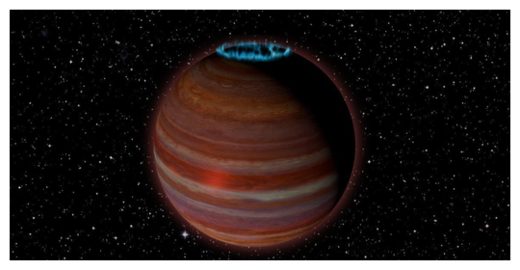
© Caltech/Chuck Carter
Magnetic fields are common in space yet their origin is poorly understood. In stars, they generate spots and flares; in planets, they can create amazing auroral displays.
Now, a team of astronomers has detected surprisingly strong magnetic fields in multiple brown dwarfs, failed stars that are too big to be planets but too small to ignite hydrogen fusion in their cores. The detections carried an even bigger surprise: unexpected auroral activity on a "rogue planet" that wanders the cosmos alone.
Melodie Kao (Arizona State University) and colleagues used the National Science Foundation's Karl G. Jansky Very Large Array to detect high-frequency radio emissions from four nearby brown dwarfs, with masses between 12 and 30 times the mass of Jupiter. Their magnetic fields are hundreds to thousands of times stronger than those around the Sun and power brilliant, radio-emitting aurorae similar to the Northern Lights on Earth. The results appear in the
Astrophysical Journal Supplement Series (
free preprint).
Among the brown dwarfs under study is SIMP0136, an object with a mass just below 13 times the mass of Jupiter - just below the dividing line that separates planets from brown dwarfs. Floating in interstellar space 20 light-years away, this planet is isolated - a "rogue planet."
On Earth, brilliant aurorae appear around the North and South Poles, where charged particles from the Sun stream in along Earth's magnetic field and crash into the upper atmosphere. A similar mechanism works at Jupiter, where the particles come from Jupiter's moons rather than the Sun. But unlike Earth and Jupiter, SIMP0136 is on its own - it either formed by itself or was flung out of another solar system. Either way, it doesn't have a parent star, so its aurorae can't come from interactions with a stellar wind.
Perhaps the planet hosts a moon of its own - but it's too soon to come to that conclusion. More observations are needed to confirm the origin of the radio emissions.
Magnetic Monsters The intensity of radio emission from SIMP0136 implies a magnetic field 200 times stronger than Jupiter's. Such a strong magnetic field "presents huge challenges to our understanding of the dynamo mechanism that produces the magnetic fields in brown dwarfs and exoplanets and helps drive the auroras we see," says Gregg Hallinan (Caltech).
The dynamo that generates Earth's magnetic field is in the outer core, where liquid iron sloshes around as the planet rotates. A similar process works in Jupiter's interior; immense pressures and temperatures near its core cause hydrogen to behave like a liquid metal. In the Sun, it's the relative motions of plasma in its inner core and convective outer layers that generate most of its magnetic field. But scientists still don't fully understand what produces the strong magnetic fields of brown dwarfs.
Radio emissions are our way of studying these fields remotely: When charged particles encounter the magnetic fields in stars, brown dwarfs, and planets, they emit radio waves. However, when Kao and her team closely examined SIMP0136 and its brown dwarf brethren, they found they couldn't easily relate the magnetic field strengths measured via radio emission to things like the object's mass, temperature, rotation period, or age. This implies that the generation of strong magnetic fields in these objects is probably much different than the mechanisms that create fields in the Sun or Earth.
Understanding brown dwarf's radio emissions will also shed light on the behavior of giant, gaseous planets, which share similar properties. Not only do these observations offer a new way to detect rogue planets, they will also further our understanding of giant planets around other stars.
Maybe you need some more dark electricity?
Some truth, lots of speculation/disinfo here,
the picture without text would have been better.